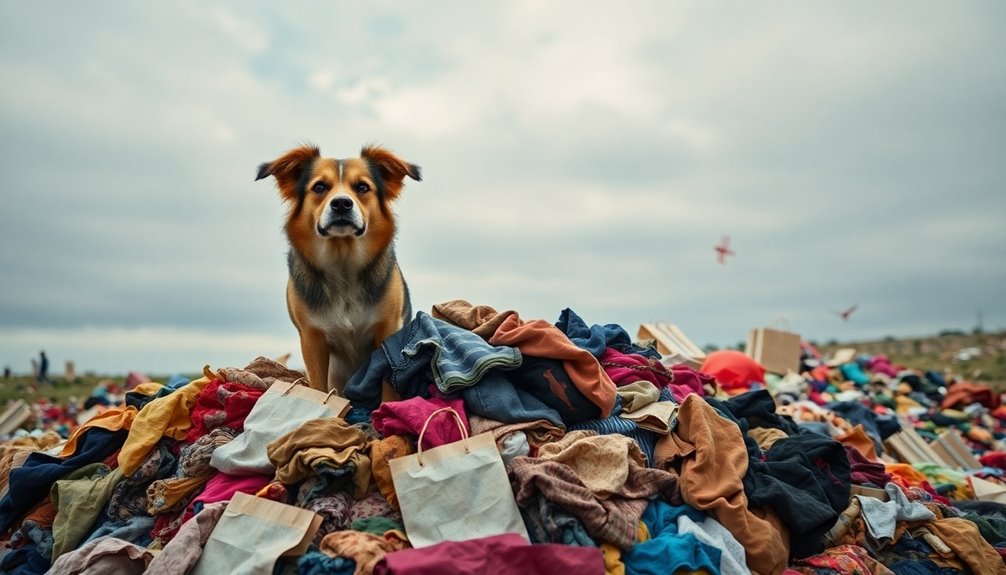Online shopping's making Europe's textile waste crisis worse. With 12.6 million tonnes of textile waste generated annually, about 82% of it comes from consumer disposal. Impulsive purchases and high return rates mean many returned items end up in landfills. Fast fashion brands fuel this disposability culture, making things worse. The EU's trying to improve recycling systems, but it needs your help. Stick around to discover how your choices can impact this pressing issue.
Key Takeaways
- Online shopping fosters impulsive buying, leading to increased textile waste as consumers often buy more than needed.
- Higher return rates from online purchases result in many returned items being discarded rather than reused.
- Fast fashion brands contribute to a disposable culture, shortening the lifecycle of garments and exacerbating waste issues.
- Currently, only 20% of textile waste in Europe is collected for reuse or recycling, highlighting systemic inefficiencies.
- The EU aims to improve textile waste management through initiatives like Extended Producer Responsibility and enhanced sorting systems.

As the fashion industry continues to thrive, a troubling reality looms: most textile waste in Europe ends up in landfills due to poor sorting and recycling systems. Each year, the European Union generates about 12.6 million tonnes of textile waste, with only 20% collected for reuse or recycling. This situation isn't just a statistic; it's a direct consequence of consumer habits, especially the rise of online shopping.
Most textile waste in Europe ends up in landfills, with only 20% being reused or recycled, largely due to consumer habits and online shopping.
When you shop online, the convenience often leads to impulsive purchases and, unfortunately, a higher return rate. This behavior contributes significantly to textile waste, as many items return to the waste stream instead of being reused. Fast fashion brands, which thrive in the online marketplace, promote a culture of disposability, where garments have a dangerously short lifecycle. With about 82% of textile waste originating from consumer disposal, the problem is escalating. Approximately 16 kg of textile waste per person is generated in the EU each year, highlighting the scale of the issue.
While the EU has made strides, such as decreasing the landfilling of textiles from 21% in 2010 to 11% in 2020, challenges remain. Sorting and recycling capacities across Europe still need significant expansion to handle the vast amounts of collected textiles effectively. Most current recycling methods are mechanical, often resulting in downcycled materials rather than new garments. This means that even if you recycle your clothes, they may not become new clothing, which is what many of us hope for when we drop them off at a recycling point.
The EU aims to implement separate collection systems for textiles and has proposed Extended Producer Responsibility (EPR) to hold brands accountable for waste management. However, disparities in how member states handle textile waste disposal complicate the situation.
As a consumer, you can advocate for sustainable practices by supporting brands that prioritize eco-friendly production and recycling methods. Your choices matter, and collectively, they can help combat the growing textile waste crisis exacerbated by online shopping.
Frequently Asked Questions
What Are the Environmental Impacts of Textile Waste in Europe?
Textile waste in Europe has serious environmental impacts. You contribute to significant water and land use pressures, as well as greenhouse gas emissions with each garment you discard.
The majority of textile waste ends up in landfills or incinerated, polluting the environment further. Fast fashion fuels this problem, leading to rapid disposal and increased waste.
How Can Consumers Reduce Their Contribution to Textile Waste?
Did you know that the average person throws away 81 pounds of clothing each year? You can reduce your contribution to textile waste by buying less and choosing quality over quantity.
Avoid fast fashion, prioritize natural fibers, and support sustainable brands.
Repairing and upcycling your clothes extends their lifespan, while engaging in second-hand markets keeps textiles in circulation.
What Regulations Exist to Manage Textile Waste in Europe?
In Europe, several regulations exist to manage textile waste effectively.
The EU Waste Framework Directive mandates separate textile waste collection by 2025, while Extended Producer Responsibility (EPR) requires producers to handle their products' lifecycle.
You'll also find harmonized rules that create a unified market for waste textiles.
Additionally, there's an urgent call for enhanced recycling capacities to tackle the rising levels of textile waste and support sustainable practices across the industry.
Are There Alternatives to Fast Fashion That Promote Sustainability?
Have you ever thought about the impact of your clothing choices? There are plenty of alternatives to fast fashion that promote sustainability.
You can opt for sustainable materials, buy second-hand, or even rent outfits for special occasions. Supporting brands that prioritize transparency and ethical practices makes a difference too.
Plus, embracing slow fashion by investing in high-quality pieces can help reduce waste while keeping your wardrobe fresh and stylish.
How Do Textile Recycling Programs Function in Different European Countries?
Textile recycling programs in Europe function through various strategies tailored to each country's needs.
In the Czech Republic, you'll separate textiles from regular waste.
Luxembourg and Belgium excel with accessible collection points and awareness campaigns.
The Netherlands promotes a circular economy, while Austria partners with nonprofits to donate reusable clothing.
Each initiative aims to increase recycling rates and reduce waste, emphasizing the importance of community involvement and sustainable practices across the continent.
Conclusion
As the watchdog warns, the growing trend of online shopping is pushing textile waste to alarming levels. It's clear that we can't ignore this issue any longer. Remember, "out of sight, out of mind" doesn't apply here; the consequences of our shopping habits are piling up. By making conscious choices and supporting sustainable brands, you can help turn the tide on textile waste. Together, we can create a more responsible future for fashion and the planet.



